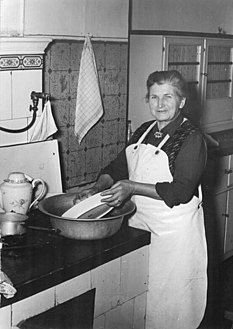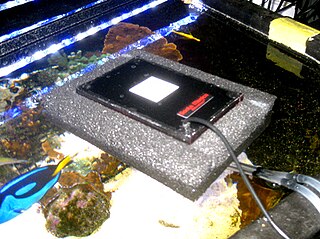
A dishwasher is a machine for cleaning dishware and cutlery automatically. Unlike manual dishwashing, which relies largely on physical scrubbing to remove soiling, the mechanical dishwasher cleans by spraying hot water, typically between 45 and 75 °C, at the dishes, with lower temperatures used for delicate items.

A washing machine is a home appliance used to wash laundry. The term is mostly applied to machines that use water as opposed to dry cleaning or ultrasonic cleaners. The user adds laundry detergent, which is sold in liquid or powder form, to the wash water.
Dry cleaning is any cleaning process for clothing and textiles using a chemical solvent other than water. The modern dry cleaning process was developed and patented by Thomas L. Jennings.

Hand washing, also known as hand hygiene, is the act of cleaning hands for the purpose of removing soil, dirt, and microorganisms. If water and soap is not available, hands can be cleaned with ash.

A water dispenser, known as water cooler, is a machine that cools and dispenses water with a refrigeration unit. It is commonly located near the restroom due to closer access to plumbing. A drain line is also provided from the water cooler into the sewer system.

Dishwashing or dish washing, also known as washing up, is the process of cleaning cooking utensils, dishes, cutlery and other items to prevent foodborne illness. This is either achieved by hand in a sink using dishwashing detergent or by using a dishwasher and may take place in a kitchen, utility room, scullery or elsewhere. In Britain to do the washing up also includes to dry and put away. There are cultural divisions over rinsing and drying after washing.

Scooba was a floor-scrubbing robot made by iRobot. It was released in limited numbers in December 2005 for the Christmas season, with full production starting in early 2006. The company introduced a lower-priced version, the Scooba 5800, in the second half of 2006. It introduced a new Scooba 450 at CES 2014 in January 2014.

A car wash or auto wash is a facility used to clean the exterior and, in some cases, the interior of motor vehicles. Car washes can be self-serve, fully automated, or full-service with attendants who wash the vehicle. It may also be an event where people pay to have their cars washed by volunteers as a method to raise money for some purpose.
Scrubber systems are a diverse group of air pollution control devices that can be used to remove some particulates and/or gases from industrial exhaust streams. The first air scrubber was designed to remove carbon dioxide from the air of an early submarine, the Ictineo I, a role for which they continue to be used today. Traditionally, the term "scrubber" has referred to pollution control devices that use liquid to wash unwanted pollutants from a gas stream. Recently, the term has also been used to describe systems that inject a dry reagent or slurry into a dirty exhaust stream to "wash out" acid gases. Scrubbers are one of the primary devices that control gaseous emissions, especially acid gases. Scrubbers can also be used for heat recovery from hot gases by flue-gas condensation. They are also used for the high flows in solar, PV, or LED processes.
In dairy farming a bulk milk cooling tank is a large storage tank for cooling and holding milk at a cold temperature until it can be picked up by a milk hauler. The bulk milk cooling tank is an important piece of dairy farm equipment. It is usually made of stainless steel and used every day to store the raw milk on the farm in good condition. It must be cleaned after each milk collection. The milk cooling tank can be the property of the farmer or be rented from a dairy plant.

Cast-iron cookware is valued for its heat retention properties and can be produced and formed with a relatively low level of technology. Seasoning is used to protect bare cast iron from rust and to create a non-stick surface. Types of bare cast-iron cookware include panini presses, waffle irons, crepe makers, dutch ovens, frying pans, deep fryers, tetsubin, woks, potjies, karahi, flattop grills and griddles.
Carpet cleaning, for appearance, and the removal of stains, dirt, and allergens is done through several methods. Clean carpets are recognized by manufacturers as being more visually pleasing, potentially longer-lasting, and probably healthier than poorly maintained carpets.

An instant hot water dispenser or boiling water tap is an appliance that dispenses water at about 94 °C (201 °F) (near-boiling). There are hot-only and hot and cool water models, and the water may be filtered as well as heated. Instant hot water dispensers became popular in the 1970s. Instant hot water dispensers are very similar to portable shower devices; the latter is fitted with a heating element and quickly heats up water, once a switch has been activated.

A parts washer is a piece of equipment used to remove contaminants or debris, such as dirt, grime, carbon, oil, grease, metal chips, cutting fluids, mold release agents, ink, paint, and corrosion from workpieces. Parts washers are used in new manufacturing and remanufacturing processes; they are designed to clean, degrease and dry bulk loads of small or large parts in preparation for assembly, inspection, surface treatment, packaging and distribution. Parts washers may be as simple as the manual "sink-on-a-drum" common to many auto repair shops, or they may be very complex, multi-stage units with pass-through parts handling systems. Parts washers are essential in maintenance, repair and remanufacturing operations as well, from cleaning fasteners, nuts, bolts and screws to diesel engine blocks and related parts, rail bearings, wind turbine gears boxes and automotive assemblies.

An algae scrubber is a water filtering device which uses light to grow algae; in this process, undesirable chemicals are removed from the water. Algae scrubbers allow saltwater, freshwater and pond hobbyists to operate their tanks using natural filtration in the form of primary production, much like oceans and lakes.

Floor scrubber is a floor cleaning device. It can be simple tools such as floor mops and floor brushes, or in a form of walk-behind or ride-on machines to clean larger floor areas by injecting water with cleaning solution, scrubbing, and lifting the residuals off the floor. With the advancement in robotics, autonomous floor-scrubbing robots are available as well.
A spray is a dynamic collection of drops dispersed in a gas. The process of forming a spray is known as atomization. A spray nozzle is the device used to generate a spray. The two main uses of sprays are to distribute material over a cross-section and to generate liquid surface area. There are thousands of applications in which sprays allow material to be used most efficiently. The spray characteristics required must be understood in order to select the most appropriate technology, optimal device and size.

Tankless water heaters—also called instantaneous, continuous flow, inline, flash, on-demand, or instant-on water heaters are water heaters that instantly heat water as it flows through the device, and do not retain any water internally except for what is in the heat exchanger coil. Copper heat exchangers are preferred in these units because of their high thermal conductivity and ease of fabrication.
Scouring powder is a household cleaning product consisting of an abrasive powder mixed with a dry soap or detergent, soda, and possibly dry bleach.












